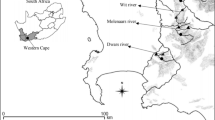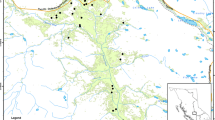Abstract
Standing crop measurements were made in emergent wetland vegetation following acute herbivory by 2 species of leaf-chewing caterpillars,Cisseps fulvicula (Ctenucidae) andAcronicta leporina (Noctuidae). Significant weight differences were found between grazed and ungrazed stands of alkali bulrush, cattail, Olney’s bulrush, and saltgrass, respectively. The greatest absolute removal was 2050 kg/ha (43%) in cattail stands and the smallest was 783 kg/ha (47%) in Olney’s bulrush. Mincral conlent of cattail leaf parts remaining after grazing was greater than that of similar but ungrazed stands, suggesting non-random feeding by these insects. Herbivory removed enough plant material to significantly change the standing crop and alter plant stand architecture of these 4 emergent species.
Similar content being viewed by others
Literature Cited
Bakker, J.P. 1985. The impact of grazing on plant communities, plant populations and soil conditions on salt marshes. Vegetatio 60:391–398.
Bentley, S. and J.B. Whittaker. 1979. Effects of grazing by a chrysomelid beetleGastrophysa viridula on competition betweenRumex obtusifolius andRumex crispus. Journal of Ecology 67:79–80.
Berg, C.O. 1950. The biology of aquatic caterpillars which feed onPotamogeton. Transactions American Microscopical Society 69:254–266.
Boyd, C.F. 1968. Freshwater plants: a potential source of protein. Economic Botany 22:359–368.
Brown, V.K. 1984. Secondary succession: Insect-plant relationships. Bioscience. 34:710–716.
Cahoon, D.R. and J.C. Stevenson. 1986. Production, predation, and decompostition in a low-salinityHibiscus marsh. Ecology 67:1341–1350.
Carter, W. 1973. Insects in relation to plant disease. Wiley Press, New York, NY, USA.
Caswell, H., F. Reed, S.N. Stephenson, and P.A. Werner. 1973. Photosynthetic pathways and selective herbivory: an hypothesis. American Naturalist. 107:465–480.
Crow, J.H. and K.B. McDonald. 1978. Wetland values: secondary production. p 146–161.In P. Greeson, J.R. Clark, and J.E. Clark (eds.) Wetland Function and Values: the State of Our Understanding. American Water Resources Association. Minneapolis, MN, USA.
Gallagher, J.L. and W.J. Pfeiffer. 1977. Aquatic metabolism of the communities associated with attached dead shoots of saltmarsh plants. Limnology and Oceanography. 22:362–565.
Joenje, W. 1985. The significance of waterfowl grazing on the primary vegetation succession on embanked sand flats. Vegetatio 62:399–406.
Klopatek, J.M. and F.M. Stearns. 1978. Primary productivity of emergent macrophytes in a Wisconsin freshwater marsh ecosystem. American Midland Naturalist 100:320–322.
Meredith, T.C. 1985. Factors affecting recruitment from the seed bank of sedge (Cladius mariscus) dominated communities on Wicken Fen, Cambridgeshire, England. Journal of Biogeography. 12:463–472.
Parsons, K.A. and A.A. de la Cruz. 1980. Energy flow and grazing behavior of conocephaline grasshoppers in aJuncus romerianus marsh. Ecology 61:1045–1050.
Pfeiffer, W.J. and R.G. Weigert. 1981. Grazers onSpartina and their predators. p. 87–112In L.R. Pomeroy and R.G. Weigert (eds.) The Ecology of a Salt Marsh. Springer-Verlag, New York, NY, USA.
Reimold, R.J., R.A. Linthurst, and P.L. Wolf. 1975. Effects of grazing on a salt marsh. Biological Conservation 8:105–125.
Scott, M.L. and J.L. Haskins. 1987. Effects of grazing by chrysomelid beetles on two wetland herbaceous species. Bulletin of the Torrey Botanical Club 114:13–17.
Skuhravy, V. 1978. Invertebrates: destroyers of common reed. p. 367–388In D. Dykyjova and J. Kvet, (eds.) Pond Littoral Ecosystems. Springer-Verlag, New York, NY, USA.
Smirnov, N.N. 1961. Consumption of emergent plants by insects. International Vereingung Fur Theoretische und angewandte Limnologie, Vergand lungen 14:232–236.
Smith, L.M. and J.A. Kadlec. 1985. A comparison of marsh plant loss estimates in production techniques. American Midland Naturalist 114:393–395.
Stinson, C.S.A. 1983. Effects of insect herbivores on early successional habitats. Ph.D Dissertation. University of England, Berkshire, UK.
Varley, G.C. 1967. The effects of grazing by animals on plant productivity. p. 773–779.In K. Petrusewicz (ed.) Secondary Productivity of Terrestrial Ecosystems. Polish Academy of Sciences, Institute of Ecology, Warsaw, Poland.
Pomeroy, L.R. and R.G. Weigert (eds.). 1981. The Ecology of a Salt Marsh. Springer-Verlag, New York, NY, USA. Wallace, J.E. and J.O’Hop. 1985. Life on a fast pad: waterlily leaf beetle impact on water lilies. Ecology 66:1534–1544.
Wallace, J.E. and J. O’Hop. 1985. Life on a fast pad: waterlily leaf beetle impact on waterlilies. Ecology 66:1534–1544.
Whittaker, J.B. 1982. The effect of grazing by a chrysomelid beetleGastropvsa viridula on growth and survival ofRumex crispus on a shingle bank. Journal of Ecology 70:291–296.
Author information
Authors and Affiliations
Rights and permissions
About this article
Cite this article
Foote, A.L., Kadlec, J.A. & Campbell, B.K. Insect herbivory on an inland brackish wetland. Wetlands 8, 67–74 (1988). https://doi.org/10.1007/BF03160809
Issue Date:
DOI: https://doi.org/10.1007/BF03160809




